Archaeological Ruins
Group "F"
Near Tapachula, Chiapas, Mexico.
Travel & Tour
Pictures, Photos, Information, Images, & Reviews.
George & Eve DeLange
Google Map To Izapa Olmec & Mayan, Archaeological Ruins
Group "F" 11 km South East Of Tapachula, Chiapas, Mexico.
This Is Said To Be Where The 2012 End Of The World Mayan Prophesy Begins!
View Larger Map
We Are Proud Of Our SafeSurf Rating!
Click On Any Of The Following Links By Amazon.Com
For Books Or Videos About The Olmec People In Mexico. No Obligation!
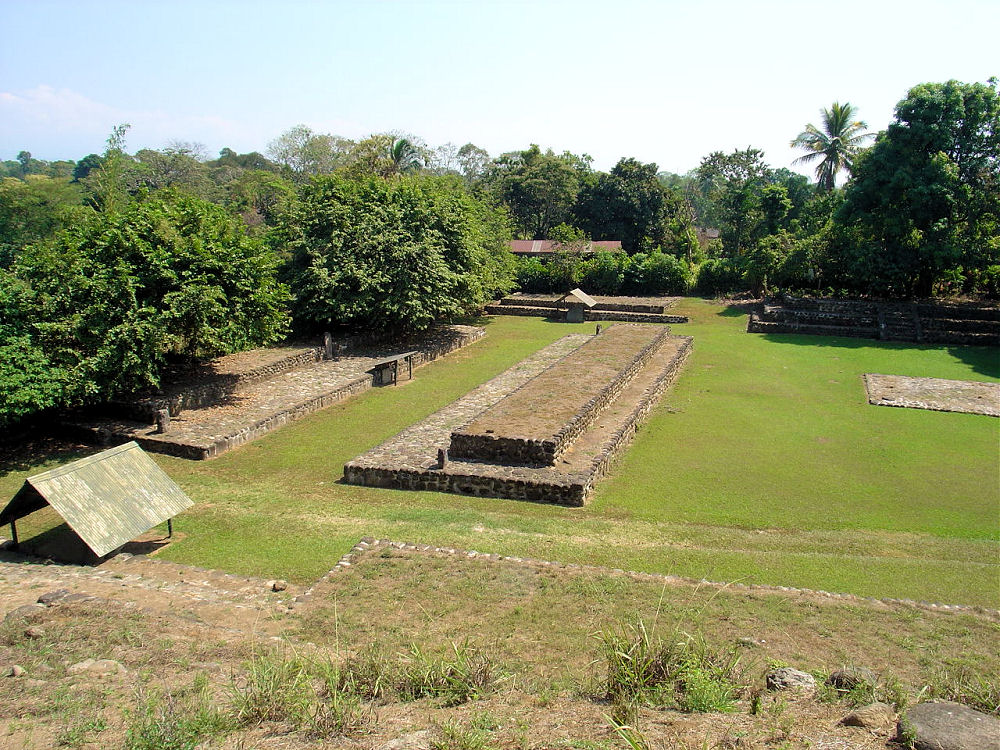
Great Ball Court Said To Be The Origin Place Of The Mayan Calendar
And Of The 2012 Mayan Prophecy Which Some Say Predicts The End Of The World! December 21, 2012.
 |
| Great Ball Court Said To Be The Origin Place Of The Mayan Calendar And Of The 2012 Mayan Prophecy Which Some Say Predicts The End Of The World! December 21, 2012. |
|---|
Izapa Archaeological Ruins:
Izapa: Located near the Guatemala border in the Mexican State of Chiapas. Take the road that leads out of the Chiapas city of Tapachula toward the Talisman Bridge near the Guatemala border town of El Carmen. If you get to Talisman Bridge, you have gone about 9km. too far. The entrance to Izapa will be on your left and it is located about eleven kilometers from Tapachula. You will also be about 1 km from the small, nice town of Tuxtla Chico, Chiapas, Mexico. The Izapa site is clearly marked with a small sign, so be alert for the sign. A Google Earth Map search marks the center of the Izapa Olmec & Mayan Archaeological Ruins, Group "F" at 14o 55' 24.16" N 92o 10' 47.36" W. The elevation is about 878 feet. There is also a small museum located in Tapachula with artifacts from Izapa on display. When we visited the museum it was closed for remodeling and they had no idea as to when it might re-open. The museum is located in the town center by the Zocolo. Parking is permitted on the street. We visited the site of Izapa on January 29, 2004. Investigations by the New World Archaeological Foundation show that Izapa was inhabited throughout the Preclassic Period into the Postclassic Period. It had a estimated population of some 10,000 and its central area that consisted of a rigorously planned urban section covered some 200 hectares: it has 13 large plazas, interspersed between mounds and it is oriented towards the geography of the region, dominated by the volcano Tacan�. This would place the first human settlers in Izapa from about 1500 to 1250 B.C. These first village people lived off of simple agriculture, an abundance of wild fruits, and cocao. Izapa was the center of the Soconusco region, a fertile area which specialized in the production of cacao. It is thought that the center of the settlement was around Mound 30 located on the North side of Group B. An investigation of the ceramics found in the area shows that between about 100 to 850 B.C. there was an influence of the West Coast Olmec Culture Styles of first San Lorenzo and then later of La Venta into the area. This was probably due to the trade for cocao, whose seed was used as money. If you look carefully at the trees surrounding the ruins today, you will see many cocao trees growing right up to the edge of the Izapa ruins themselves. It is thought that the language of the early Izapa people was Mixe-Zoquean which was prevelent in the Olmec heartland. Therefor, Izapa was probably an outpost on the SouthEast edge of the Olmec Empire. Izapa changed from simple village life to geing a civic-religious center sometime about 850 to 300 B.C. Group B Complex still remained the center of the town, but at this time the large platform mounds rose around the plaza. Then the early stages of Group A and C were erected. Izapa's role as an outpost town became increasingly more important since to the east of town the early stages of the Mayan Civilization along the Pacific Coast of Guatemala and into Kaminaljuyu known today as Guatemala City began to show their influence into the area. It was at this time that La Venta's power began to collapse and the first large stone monuments at Izapa were carved. Izapa reached its highest power between 300 to 50 B.C. Contacts with the Olmec culture disappeared and Izapa rose in its own glory and power. Groups A, B, C, and D reached their present forms and the great stone monuments of Izapa were carved at this time. Izapa was the dominant civic center of the Soconusco region and evidence of Izapa's Long Lipped God shows its influence clear into Kaminaljuyu the early Maya city located under present day Guatemala City in Guatemala. Both the Long Count Calendar and a writing system have not yet been discovered at Izapa. Group F and the Izapa site is oriented 21� east of true north, which is the sight line to the peak of Tacan� volcano. Also this alignment is perpendicular to this main axis as sighted on the Winter Solstice Horizon. Research is now being done which may lead to the conclusion that the Long Count Calendar may have its roots from observations completed at Izapa. In about 50 B.C. Izapa's growth suddenly stops. There are signs of some building at Group F which appears to be the new civic religious center of the area. Ceremonial use of groups A, B, C and D stops. Ceramic evidence then shows a strong influence from Kaminaljuyu in Guatemala. Between 100 to 200 A.D. influence from the East seems to end. After 250 A.D. the ceramics then show a strong Soconusco style and the only group that seems to be inhabited is group F with the rest of the groups becoming garbage dumps. By about 1200 A.D. Izapa was abandoned. At the time of the Spanish conquest, the Aztecs had conquered the area and were using it to grow cocao trees. The area was called Xoconocheo until conquered by the spanish and it became a providence of New Spain. It is estimated that Izapa had a population of some 10,000 people at its peak of growth. Its central area consisted of a rigorously planned urban section covering about 200 hectares. Izapa has 13 large plazas, interspersed between several mounds and it is oriented towards the volcano Tacan�, which is 4,064 meters in height. When you visit Izapa the thick growth of cacao trees makes it difficult to see many of the buildings. It also is easy to mistake some of the mounds for the natural geography and plant growth surrounding the various access paths that lead to the nearby farmhouses. Only three sectors can be visited: Groups A, B and F, which are located on land whose owners �lend� the property to the National Institute of History and Anthropology (INAH). This same land is also used for growing crops of cocao and as pasture ground. What the visitor sees is only about 1.5% of the total area of the ruins. We are including a few pictures on this page of Cocoa growing since there are few actual photos of growing Cocoa trees and seedlings on the internet. We are even showing the sprouting of some Cocoa seeds that we are attempting to grow. We doubt that we will have much success, but we will give it a try. Check back ever so often and we will show our progress in this attempt. When you visit the site you will pass through the front and back yards of the many farm houses that cover the area. Be sure to remember that you are a guest upon other peoples private property. Some of these people are having a hard time just to make enough money to get by. It would be appropriate to make a small donation to these people for parking upon their property as you feel fit to make. Perhaps the most controversal and important stele in the MesoAmerican World is located at Izapa. It is Stele 5. Stele 5 is located in Group A. We are including ample photographs and drawings of the stone on the Izapa Group A page for your examination. All of the photographs on this page are of Group F. Izapa Group F contains the Great Ball Court that is said to be the Origin Place of the Mayan Calendar and of the 2012 Mayan Prophecy which some say predicts the end of the world! December 21, 2012. Basically, this prophecy is due to the alignment of the monuments at the East and West ends of the Great Ballcourt with the Rising Sun at Winter Solstice and also with the Dark Area or Bow of the Milky Way. The Snakes Head in the North cornfield also will align at the same time. That will take place on December 21, 2012 at about 4:27 AM in the Morning. These sorts of prophecies have been said before and the world keeps on moving, so we don't take them too seriously. While it would be interesting to be at Izapa to see this galactic allignment, we are sure the world will continue to survive and we can still plan more vacations to Izapa.
|
Click On Any Of The Following Links By Amazon.Com
For Books Or Videos About The Mayan People In Mexico. No Obligation!
A great place to stay when visiting Izapa is the nearby business city of Tapachula (tah-pah-CHOO-lah): The n�huatl word, (TLAPACHOLI) means "flooded House."
Tapachula is located in the SE corner of Mexico in the state of Chiapas at the base of the Guatemalan Highlands, near the border of Guatemala and the Pacific Ocean. The city is the commercial center of a coffee-growing region and has thrived in coffee export. It is an important transportation link between Mexico and Central America.and hosts a large European and Asian population. In fact, Tapachula is considered to be an important city in the national economy of Mexico. Tapachula exhibits the typical style of Spanish built cities with a Central Park surrounded by the Municipal Palace. The Old Municipal Palace is now the House of Culture for the city.
Ceramics and leather goods are produced by local artisans. It is also a land route for the cocaine trade between Guatemala and Mexico. If driving between Guatemala and Mexico through Tapachula, expect to be stopped by the army or police at one of the checkpoints. The locals usually avoid the checkpoints by walking overland through the jungle with their illegal cargo.
One place of interest is the Museo Arqueologico del Soconusco which is a small museum displaying local finds. Including some finds from Izapa. Everything is in Spanish. It is open 11 am to 6 PM every day except Mondays. Located at the main plaza, which is called Parque Hidalgo.
Tapachula also sits at the base of an extinct volcano called El Tacan�. El Tacan� is important in the archaeology of the area since many structures at Izapa were aligned to El Tacana.
We have links on this page that will connect you with one of the best hotels in Tapachula. TAPACHULA, CHIS. KM. 3.5 CARRETERA A PUERTO MADERO, TAPACHULA DE CORDOVA Y ORDO EZ
TAPACHULA, 30700 MEXICO.
Holiday Express Tapachula is a modern new hotel with spacious and comfortable and functional facilities. It is located in their newest and largest shopping area, located just 10 km from the airport. Enjoy delicious complimentary Express Breakfast daily.
We suggest getting a hotel and then letting them arrange either a car or a tour of Izapa. If you call their Concierge Services ahead of your arrival, all of this can be pre-arranged for you.
We do this all the time, when traveling in Mexico. It is safe and it works!!! We have never experienced a problem, doing it this way!
Tapachula International Airport (IATA: TAP, ICAO: MMTP) is the international airport located at Tapachula, Chiapas, Mexico. It is Mexico's southernmost airport. It handles national and international air traffic for the city of Tapachula.
Therefore, we have placed a link to Priceline.com on this page so you can arrange your flights into and out of Tapachula; as well as your hotel, when visiting this area.
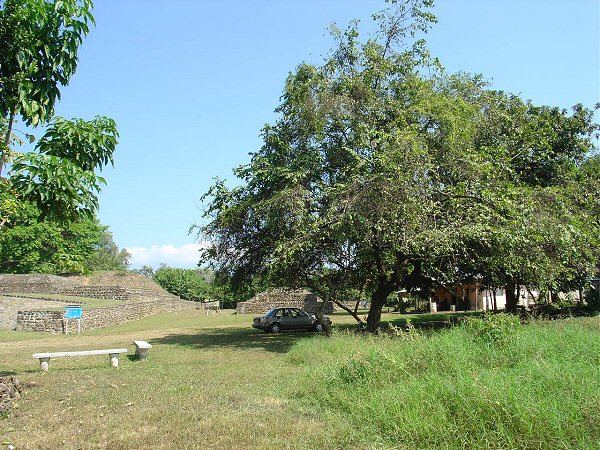
Our Rental Car In The Izapa Parking Lot At The Caretakers Yard.
Group "F" is here.
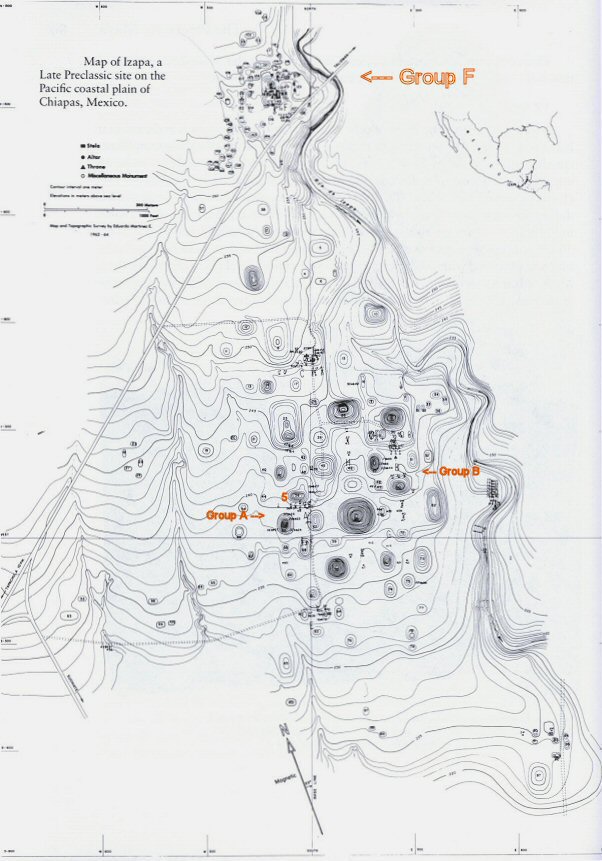
Map Of Izapa By Edwardo Martinez E. 1962 - 1964.
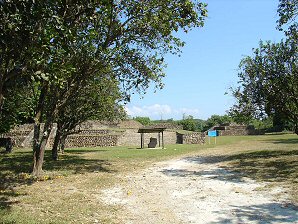
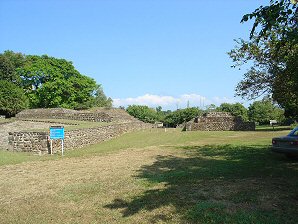
Group F, Looking North. Group F,
Structure 125 Is On Left. 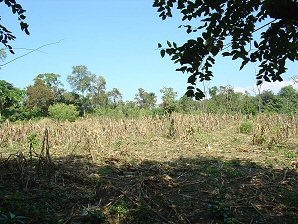
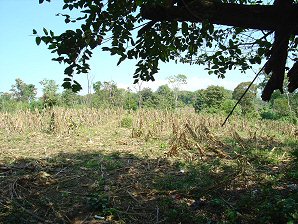
Corn Field
North Of Ball Court. Corn Field
North Of Ball Court. 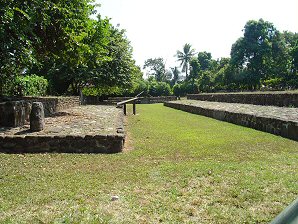
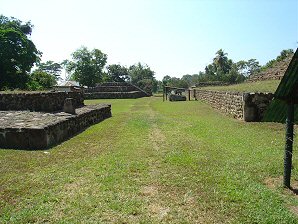
Ball Court,
Left Is North. West End Of Ball Court
Looking South. 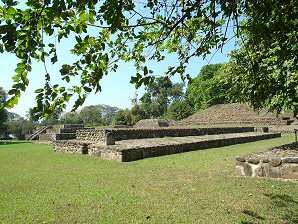
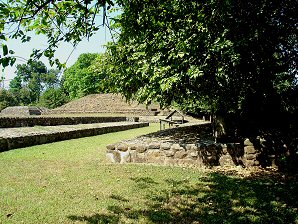
Ball Court
Looking South West. Ball Court
Looking South West. 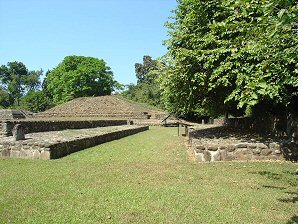

Ball Court
Looking West. Looking West From
South End Of
Structure 128. 

Looking West From
Between N End
Structure 129 And
South End Structure 128. Looking West From
North End
Of Structure 129. 
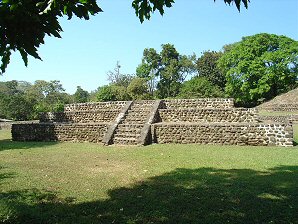
Looking West From
West Side Of Structure 129. East Side Of Structure 130
Looking West. 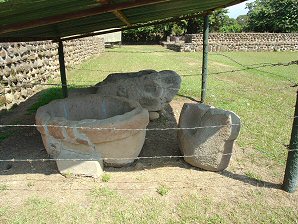
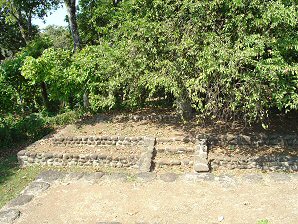
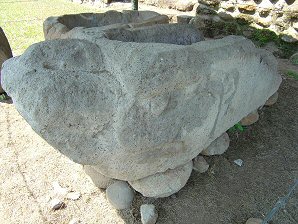
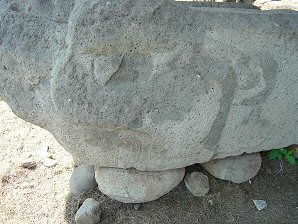
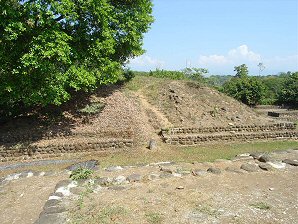
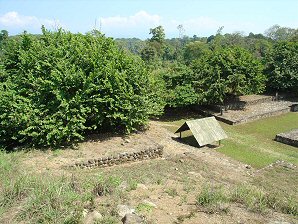
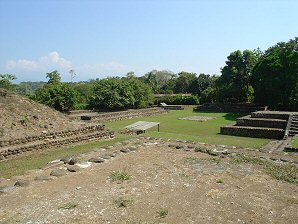

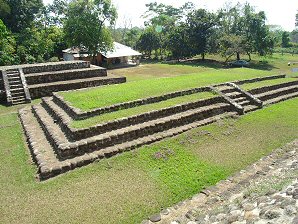
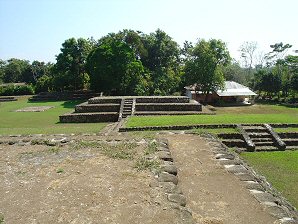
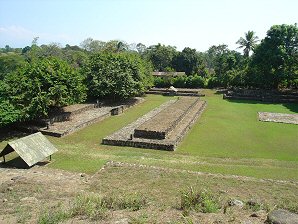
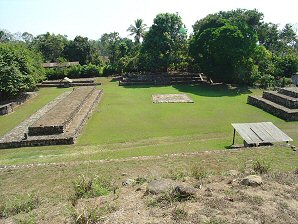
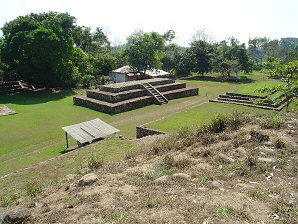
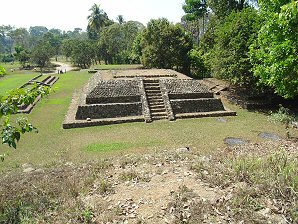



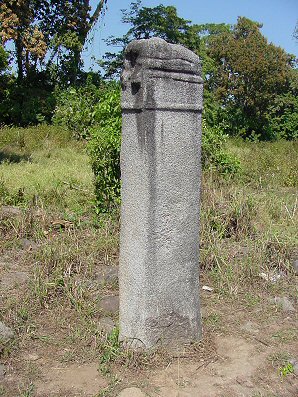
Stele 4
In Farmers Field. North Of
Structure 125 In Group F. 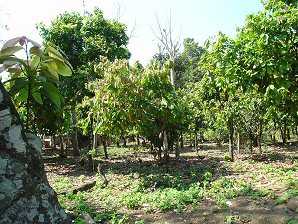

Cocao Trees,
Theobroma cacao
Growing Up To The Ruins. Cocao Trees Growing
Up To The Ruins. 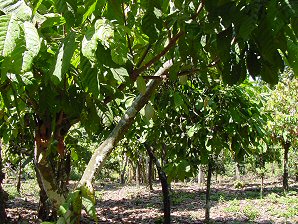
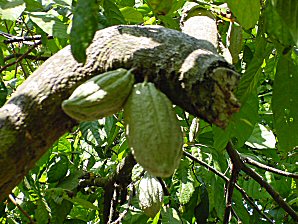
Cocao Orchard. Green Immature Cocao Fruit. 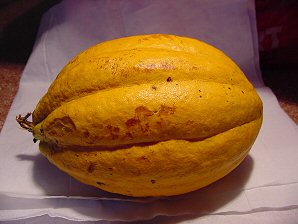
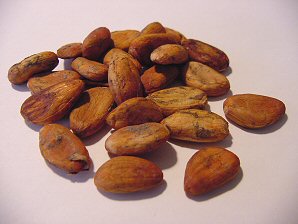
Mature Cocao Fruit
Before Seeds Are Dried.
They Will Grow Into Plants
About 35 Seeds Per Fruit. Dried Cocao Seeds
Can Be Ground For Chocolate.
Will Not Grow Into Plants 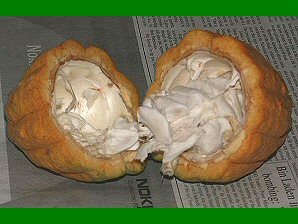
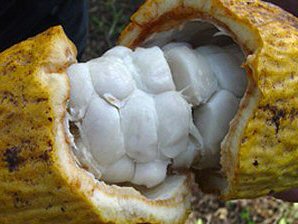
Mature Cocao Fruit
Fresh Seeds Grow Into Plants. Seeds Surrounded By
A Sugar Type
Of Coating That When
Fermented Gives
Chocolate Flavor. 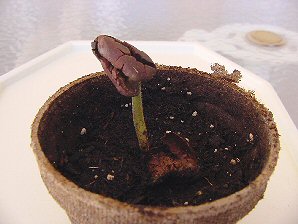
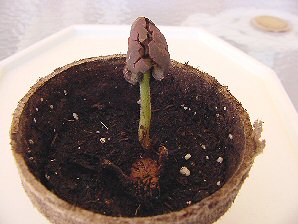
Cocao Seed Sprout
Side View. Cocao Seed Sprout
Anterior View. 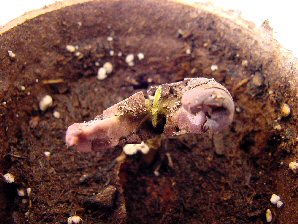
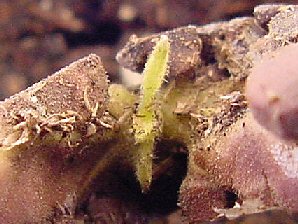
Cocao Seed Sprout
First Leafs. Cocao Seed Sprout
First Leafs. 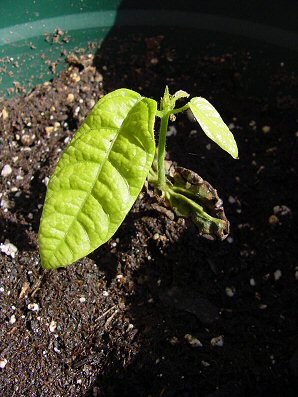
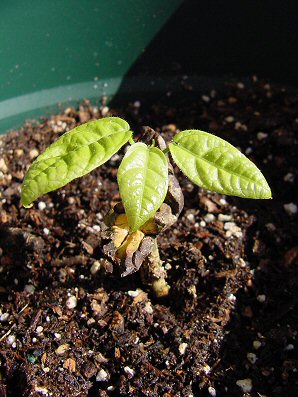
Young Cocao Plant
19 Days Old. Young Cocao Plant
19 Days Old.
Click On Any Of The Following Links By Amazon.Com
For Books Or Videos About Touring In Mexico. No Obligation!
Click On The Bottom Link Marked GO, Then Look At The Bottom Of The Page That Comes Up.
There You Will See Travel Agencies That Are Recommended By Amazon.Com
For Touring In Mexico. No Obligation!
Here Are Some Links To The Very Best & Most Popular Items Sold On Amazon.Com
To Learn More! Click The Links Below. No Obligation, Of Course!
Click Links Below For Other Izapa Attractions!
A great place to stay when visiting Izapa is the nearby business city of Tapachula (tah-pah-CHOO-lah): The n�huatl word, (TLAPACHOLI) means "flooded House." Tapachula is located in the SE corner of Mexico in the state of Chiapas at the base of the Guatemalan Highlands, near the border of Guatemala and the Pacific Ocean. The city is the commercial center of a coffee-growing region and has thrived in coffee export. It is an important transportation link between Mexico and Central America.and hosts a large European and Asian population. In fact, Tapachula is considered to be an important city in the national economy of Mexico. Tapachula exhibits the typical style of Spanish built cities with a Central Park surrounded by the Municipal Palace. The Old Municipal Palace is now the House of Culture for the city. Ceramics and leather goods are produced by local artisans. It is also a land route for the cocaine trade between Guatemala and Mexico. If driving between Guatemala and Mexico through Tapachula, expect to be stopped by the army or police at one of the checkpoints. The locals usually avoid the checkpoints by walking overland through the jungle with their illegal cargo. One place of interest is the Museo Arqueologico del Soconusco which is a small museum displaying local finds. Including some finds from Izapa. Everything is in Spanish. It is open 11 am to 6 PM every day except Mondays. Located at the main plaza, which is called Parque Hidalgo. Tapachula also sits at the base of an extinct volcano called El Tacan�. El Tacan� is important in the archaeology of the area since many structures at Izapa were aligned to El Tacana. We have links on this page that will connect you with one of the best hotels in Tapachula. TAPACHULA, CHIS. KM. 3.5 CARRETERA A PUERTO MADERO, TAPACHULA DE CORDOVA Y ORDO EZ TAPACHULA, 30700 MEXICO. Holiday Express Tapachula is a modern new hotel with spacious and comfortable and functional facilities. It is located in their newest and largest shopping area, located just 10 km from the airport. Enjoy delicious complimentary Express Breakfast daily. We suggest getting a hotel and then letting them arrange either a car or a tour of Izapa. If you call their Concierge Services ahead of your arrival, all of this can be pre-arranged for you. We do this all the time, when traveling in Mexico. It is safe and it works!!! We have never experienced a problem, doing it this way! Tapachula International Airport (IATA: TAP, ICAO: MMTP) is the international airport located at Tapachula, Chiapas, Mexico. It is Mexico's southernmost airport. It handles national and international air traffic for the city of Tapachula. Therefore, we have placed a link to Priceline.com on this page so you can arrange your flights into and out of Tapachula; as well as your hotel, when visiting this area.
|
 |
| Our Rental Car In The Izapa Parking Lot At The Caretakers Yard. Group "F" is here. |
|---|
 |
| Map Of Izapa By Edwardo Martinez E. 1962 - 1964. |
|---|
 |  |
| Group F, Looking North. | Group F, Structure 125 Is On Left. |
|---|---|
 |  |
| Corn Field North Of Ball Court. | Corn Field North Of Ball Court. |
 |  |
| Ball Court, Left Is North. | West End Of Ball Court Looking South. |
 |  |
| Ball Court Looking South West. | Ball Court Looking South West. |
 |  |
| Ball Court Looking West. | Looking West From South End Of Structure 128. |
 |  |
| Looking West From Between N End Structure 129 And South End Structure 128. | Looking West From North End Of Structure 129. |
 |  |
| Looking West From West Side Of Structure 129. | East Side Of Structure 130 Looking West. |
 |  |
 |  |
 |  |
 |  |
 |  |
 |  |
 |  |
 |  |
 |  |
| Stele 4 In Farmers Field. | North Of Structure 125 In Group F. |
 |  |
| Cocao Trees, Theobroma cacao Growing Up To The Ruins. | Cocao Trees Growing Up To The Ruins. |
 |  |
| Cocao Orchard. | Green Immature Cocao Fruit. |
 |  |
| Mature Cocao Fruit Before Seeds Are Dried. They Will Grow Into Plants About 35 Seeds Per Fruit. | Dried Cocao Seeds Can Be Ground For Chocolate. Will Not Grow Into Plants |
 |  |
| Mature Cocao Fruit Fresh Seeds Grow Into Plants. | Seeds Surrounded By A Sugar Type Of Coating That When Fermented Gives Chocolate Flavor. |
 |  |
| Cocao Seed Sprout Side View. | Cocao Seed Sprout Anterior View. |
 |  |
| Cocao Seed Sprout First Leafs. | Cocao Seed Sprout First Leafs. |
 |  |
| Young Cocao Plant 19 Days Old. | Young Cocao Plant 19 Days Old. |
Click On Any Of The Following Links By Amazon.Com
For Books Or Videos About Touring In Mexico. No Obligation!
Click On The Bottom Link Marked GO, Then Look At The Bottom Of The Page That Comes Up.
There You Will See Travel Agencies That Are Recommended By Amazon.Com
For Touring In Mexico. No Obligation!
Here Are Some Links To The Very Best & Most Popular Items Sold On Amazon.Com
To Learn More! Click The Links Below. No Obligation, Of Course!
Click Links Below For Other Izapa Attractions!
To Learn More! Click The Links Below. No Obligation, Of Course!
Click Links Below For Other Izapa Attractions!






